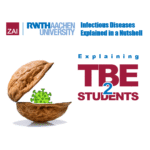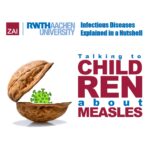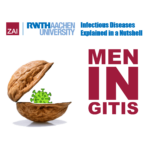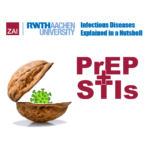Schlagwort: ‘zoonoses’
Ebola Outbreak: A Global Concern and Lessons Learned for a Resilient Future
Disclaimer!
This article and its major media content are produced by students to train science communication as part of a lecture about human infectious pathogens. The article does not represent official advice from the authorities. For authorized information about the disease in question, please refer to the official health authorities in your country or the World Health Organization.
By Kerstin Lehnen and Lena Rocca
Introduction
In recent headlines, the Aachener Newspaper has highlighted a concerning development – the reemergence of Ebola in the Democratic Republic of Congo. In this article, we embark on a journey to understand the historical context of the virus, particularly the devastating outbreak from 2014 to 2016. We will also delve into the current situation in Congo, exploring the characteristics of the Sudan Ebola virus responsible for the recent outbreak. Along the way, we will provide valuable resources, including an engaging video by science influencer SciFluencis* and an enlightening podcast hosted by Sciencefacts*. Get ready to uncover the global impact of Ebola and the invaluable lessons we’ve learned along the way.
The Devastating Outbreak of 2014-2016
Between 2014 and 2016, West Africa experienced the longest and largest Ebola outbreak in history. Originating in Guinea in December 2013, the virus rapidly spread across borders, resulting in over 28,600 reported cases and a tragic death toll of 11,325. Although Germany didn’t directly witness any cases, travelers infected with the virus introduced it to the country. Through international collaboration, enhanced disease surveillance, and effective treatment measures, the epidemic was eventually brought under control.
The Current Ebola Outbreak in Congo
On August 21, 2022, the Ministry of Health of the Republic of the Congo reported a new Ebola outbreak. Confirmed through rigorous medical tests, the outbreak persisted from August 21 to September 27, 2022, with 164 reported cases. Among them, 142 cases were confirmed, while 87 patients successfully recovered and 55 tragically lost their lives. The Sudan Ebola virus was identified as the cause, posing a challenge as there are currently no approved therapeutics or vaccines for this strain.
Unraveling the Sudan Ebola Virus
Belonging to a group of six Ebola virus species, the Sudan Ebola virus is a rare but life-threatening infectious disease. Originating in wild animals, the virus is transmited to humans through contact with infected animals. Human-to-human transmission primarily occurs through physical contact with Ebola patients or deceased individuals. The virus spreads mainly through bodily fluids, necessitating robust containment and prevention measures.
Expanding Your Knowledge
To gain a deeper understanding of Ebola and its implications, we recommend exploring additional resources. SciFluencis*, renowned science influencers, have produced a captivating video titled „What is Ebola?“ that offers an in-depth explanation of the virus:
—
Furthermore, in our quest to understand the global preparedness and response efforts, we turn to the enlightening podcast hosted by Sciencefacts*. In this thought-provoking podcast episode, hosted by Laura* and Julia*, university students in the field of infectious diseases shed light on the progression of an Ebola infection:
—
Conclusion
The resurgence of Ebola in Congo serves as a powerful reminder of the persistent threat posed by this deadly virus. Yet, by embracing international collaboration, bolstering disease surveillance, and advancing treatment and prevention strategies, we can strive to minimize its impact. Our collective commitment to learning from past outbreaks and staying informed through credible resources enables us to contribute to global efforts in tackling Ebola and safeguarding public health.
Let us remember that knowledge and awareness are our greatest weapons against infectious diseases like Ebola. By staying informed and working together, we can build a future resilient to such global health challenges. Stay informed, stay safe, and join us in our pursuit of a healthier world.
*fictious characters
About the authors:
 Lena Rocca
Lena Rocca
Age 23, 2nd semester Biology M. Sc., major: Medical Life Science
 Kerstin Lehnen
Kerstin Lehnen
Age 22, 1st semester Biology M. Sc., major: Neurobiology
Avian Influenza – Current Global Situation and Risk Assessment in Germany (May 2023)
Disclaimer!
This article and its major media content are produced by students to train science communication as part of a lecture about human infectious pathogens. The article does not represent official advice from the authorities. For authorized information about the disease in question, please refer to the official health authorities in your country or the World Health Organization.
By Laura Charlier and Meryem Pehlivan
In April 2023, the Ministry of Health in Chile reported a human infection caused by avian influenza A virus (H5N1) in Chile. Avian influenza A is a highly contagious disease mainly occurring in poultry. H5N1 is the most prominent subtype of the highly pathogenic avian influenza (HPAI) detected in infected birds.
Since December 2022, more than 120 outbreaks of avian influenza in bird populations have been documented in Germany, two of which were reported in May. In some cases, other wild animals were affected. According to the Friedrich-Loeffler institute, four cases of infected foxes have been reported this year.
Transmission from animals to humans is rare but can happen due to direct contact to an infected animal or to infected material, like saliva or feces. Human-to-human transmission is extremely rare and was reported in only a few cases, mostly after prolonged and unprotected contact with an infected, symptomatic person. Learn more about the transmission paths.
The range of symptoms due to an HPAI infection begins with no symptoms or mild illness to severe disease including lower respiratory tract disease, severe pneumonia with respiratory failure and multi-organ failure. The approximate case fatality proportion is 40-50%.
According the Centers for Disease Control and Prevention (CDC), 13 cases of human infection with avian influenza A (H5N1) have been reported worldwide since 2020. There are no cases of human infections known in Germany.
The general risk for an infection with an HPAI is currently low. However, it is important to take precautions. Three main aspects for keeping the risk low should be considered:
1: Monitoring
If you had contact to a sick or dead wild bird and develop symptoms like fever, cough, headache or muscle ache, contact your local health department and follow their instructions.
***
2: Prevention
There are many ways of preventing yourself of an infection with avian influenza. The veterinarian Claudia Miller* talks about what you need to know about bird flu and the preventive steps you should always keep in mind.
***
3: Education
As children are very curious and like to play in nature, it is extremely important to teach them in young age how to behave around wild animals. The following explanatory video may help your child to understand the possible risks.
If you are a teacher in an elementary school, consider to educate your students about the bird flu and other zoonotic infections. This information material provided by the WHO visualizes important facts accessible for young children.
Informing yourself about updates is crucial in order to adapt to changes of the current situation. If you are interested, you can use further material and read about the avian flu. Always keep in mind to use trustworthy sources and check if the given information can be verified. A current statement of the infection biologist Ayda Mellinger* addresses the question how to deal with the global bird flu situation.
*fictious character
About the authors:
 Laura Charlier
Laura Charlier
Age 25, 1st semster Biology M. Sc., major: Medical Life Science
„I think it’s crucial as a scientist to communicate scientific topics to the public. It’s not only interesting and fun to create a Blog article, but also very hard to put yourself into the position of your target audience! Therefore, seminars like this are really helpful to develop communication skills.“

Meryem Pehlivan
2nd semester Biology M. Sc., majors: Microbiology and Genetics
„I think that science communication is a very important task and skill that every scientist should master. For me, this seminar was an opportunity to learn these skills.“






